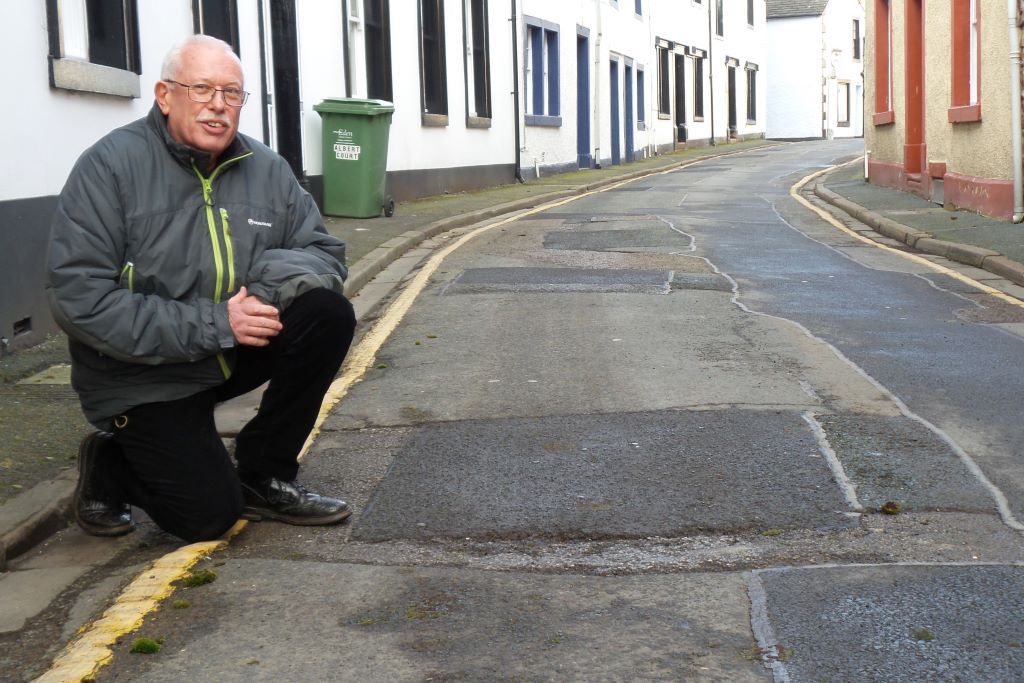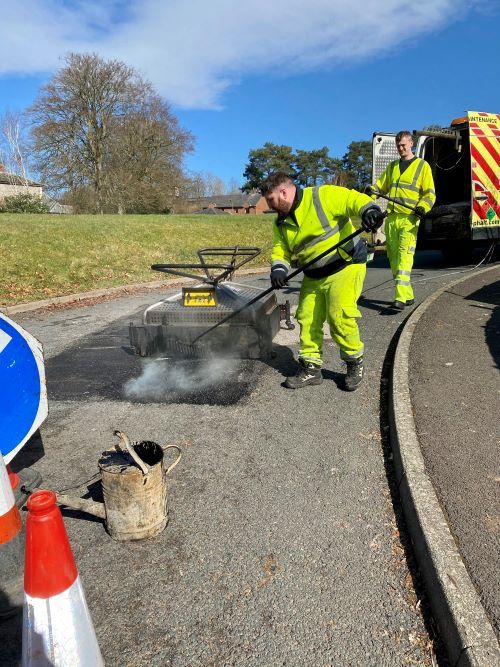
This winter has proved a perfect storm for potholes. The coldest December in 12 years, and a continuation into 2023 of the frost-thaw-rain cycle sees water get into the road, which then freezes, expands, breaks the road which then crumbles into a thaw. Across October, November and December, the RAC said there had been a 23 per cent rise in breakdowns caused by potholes and predicted worse to come.
It spells costly repairs for cars, with damaged shock absorbers, broken suspension springs and distorted wheels. NFU Mutual too is understood to have faced a series of claims locally. Meanwhile, Fill That Hole, a website run by Cycling UK, charting road defects, claims that Cumbria, has 3,230 “open hazards”. You’ll find crater complaints from across Keswick and Allerdale, but it’s a familiar story all over. ELLIS BUTCHER reports.

Retired roads policing sergeant John Forrester served as a police traffic officer locally for many years.
John, of Penrith, has considerable experience investigating serious and fatal road accidents.
So just how dangerous are potholes, I ask.
“There’s always the potential for an accident to occur from a pothole but it usually tends to be driver error – inattentive driving, poor observancy and impatience,” says John.
“Speed, obviously, is a major factor as well.”
But he does not recall a fatal accident from a pothole or one being a contributory factor.
However, road defects are a part of any serious collision investigation when the police are looking for “causation” factors.
“The problem in winter is you don’t know if a pothole is half-an-inch or more because it’s full of rainwater. In terms of risk I don’t honestly think we can differentiate because there’s a risk to all road users from potholes, and don’t forget pedestrians in that either.”
Each death on the road is estimated to cost the public purse around £2.7m. “Per. Death,” John emphasises.
That’s why he is heavily involved in the North Cumbria and South West Scotland ROSPA Group. The Royal Society for the Prevention of Accidents. He set it up in 2017 because: “One road death is one death too many, and myself and colleagues have investigated far too many.”
A former chairman, he is now a RoSPA standard examiner and advanced tutor and mentor within the group.
Of potholes, John says: “The damage that can be sustained is considerable – tyres are expensive, rims are expensive and then you have repairs to cars too.”
His own son suffered £500 worth of damage to his car on the road down to St John’s in the Vale.
John said the worst road locally was the A592 between Rheged and Kirkstone Pass, currently the focus of massive improvement works. Wrynose and Hardknott passes are in a poor state too, he said.
John says the county council highways teams do what they can but it’s a losing battle.
“If you go back years, roads used to be maintained from the proceeds of what used to be the Road Fund Licence, effectively the tax disc. Anyone who paid it as a motorist, it was then re-distributed to maintaining the roads and infrastructure. What we have now is vehicle excise duty and it all goes into the Treasury and is re-allocated.
“In a place like Cumbria with the weather and all the use we get, the reason potholes happen is surface wear and tear. It’s a combination of winter weather – freeze and thaw. The water gets into the under-layer, it then freezes, it expands, it then breaks the surface, people run over it and the more weight you have on it, the more likely it is to break.”
A hole lot of bother for Cumbria’s highways team

If Cumbria’s highways network was a single continuous road it would span a good width of Russia, by far the largest country in the world.
The county council alone maintains nearly 5,000 miles (7,900km) of highway, the equivalent in length to nearly four return trips from John O’Groats to Land’s End.
Karl Melville, a senior manager for highways at Cumbria County Council, sets out some of the challenges it faces, but he is realistic and not defensive.
“It’s a bit like painting the Forth Bridge. Just when you think you’re on top it’s time to start again because winter comes.”
400 POTHOLES EVERY WEEK
From March to September last year, the county council went on a potholing blitz.
The idea being to try and get the fixes in before winter 2022-23 when the bad weather makes them worse.
That work now seems to correspond with a fall in the number of reported potholes, says Karl.
“On average, this time last year 2021-22, we were averaging around 600 potholes being reported every week. This year 2022-23 it’s down to around 400 a week which is a reduction in the number being reported.”
From the end of this month to the end of March this year, a “jet-patcher” is also coming back to start tackling the defects identified this winter, while there is also a team of inspectors and a simple online tool to report potholes.
A RACE AGAINST THE WEATHER
“I don’t think we’ll ever be on top of it. We are out every day filling potholes, it doesn’t matter what time of year it is. Obviously, the colder weather is not good.
“To fill a pothole you need the material to be hot and when it’s so cold, the temperature in that material drops significantly.
“It’s time critical and if it’s too cold, whatever you put in will just blow out, break up and it’s a pointless exercise.”
That means they have a short window to do the work, with public expectations high.
“There is an expectation of us getting everything and everywhere done as quickly as possible, but what has to be understood is that the network is constantly getting bigger,” he said.
STAFF SHOW TRUE GRIT
Says Karl: “You only have to look at the size of Cumbria and all the (housing) developments going on. Our network is getting bigger every year and that’s another burden on the highways budget.
“The people we have doing the work on the potholes are the same staff who are out driving the gritters and putting salt down on the network, so we cannot deal with potholes at the same time.
“There’s a lot of pressure put on the highways teams because, totally understandably, everyone wants to get on and use the road network.”
The tourism effect is also a factor.
“If you look at the size of the road network in Cumbria, we have the added complication of 18 million visitors wanting access to that network every year.
“The funding we get from the Department for Transport is based on the per-head population of Cumbria. So we’re funded for hundreds of thousands of people, but we get millions of visitors using the network – it’s that simple.”
“Factor in also that material costs in the past 12 months have also more than doubled in most areas.”
HEAVIER, BIGGER VEHICLES
It’s noticeable on rural roads that larger, wider, heavier vehicles dominate now in a way they never used to.
Karl says: “I’m old enough to remember little Massey Ferguson tractors. If you look at tractors now they can easily be up to 15-tonnes.
“That doesn’t just have a potential effect on the highway but also the farmer’s fields. The field tiles (the pipes used to transport sub surface water off land and into ditches) – were not put in to take the weight of the size of tractor there is today.
“That can do a lot of damage to field drains which means a lot of water from fields can subsequently end up on our highway.”
A ROUGH GUIDE TO FIXING
“The public may see us filling a hole with material to make it safe – that doesn’t mean it’s a permanent repair. It’s temporary to make the network safe for the public to continue to use until we can get out and do it.”
A jet-patcher is a one-person operation and is very quick. It uses high-pressured air to clean out the pothole and then to force stone and bitumen back in. This is to achieve the necessary compaction and make it a solid surface.
“This is rather than excavating and breaking the surface, which in itself can cause damage by the vibration through the network and traumatise the road surface.”
“Thermal patching is slightly different in that you have a very large super-hot heated pad that heats up the existing surface to turn it back into hot material.
“Again, we’re not causing disruption to the network to break it out and we add a minimum amount and are basically recycling the existing pothole and putting it back in with a small amount of additional new material.
“There’s a massive benefit to that. It means that we’re not taking anything to tip, anything we remove, we re-use there and then. We’re not taking anything to tip and putting new material in, we’re what’s already there.”








